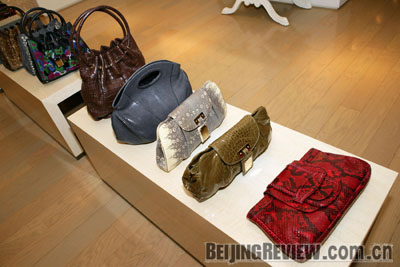|
In recent years, jade ornaments seemed to have replaced gold, silver or even diamonds in their return to popularity. The color of jade is the most important element to measure its value. Emerald green jade tops others, and its value decreases if the color is purple, red, yellow, black, or white. The purity and transparency of the stonea are another important criteria for measuring jade. The more transparent the jade is, the higher the quality. The feeling when you stroke jade ornaments is also important. Only jade items that feel silky and are creatively designed are regarded as top quality.
Handbag

A small but exquisite handbag best suits a qipao. Currently, the style used features small bags with intricate bead and silk embroidery.
There are two principles when choosing a handbag for a qipao: One is that a big bag is not suitable for qipao, and the other is that the color of the handbag can be chosen from any of the colors used in the qipao that is worn. A single-color bag is preferable.
Another way to make an impact is to use a damask handbag or a red silk bag. Some handbag producers also provide products with Chinese designs, such as Peking Opera costumes, Chinese knots or Chinese calligraphy.
Cape
A cape, short and flowing over elegant shoulders, is an essential part of wearing a qipao. If it is well-colored, the cape will add to the overall style of the qipao, apart from its prime function of keeping the wearer's shoulders warm.
The type of material used to make capes can vary from silk, voile or satin, to thick materials like wool, fleece or fur. How to match the cape with the qipao is crucial. If the qipao material is of high-quality, such as cashmere, the cape should be fur or wool. If the qipao has only one color, the cape needs to be colorful. While on the contrary, if the qipao is colorful, a single, cold color cape works well.
What should be mentioned here is that if the cape is a fur, it should be short and simple in design so it does not cover or detract from the qipao. Of course, the choosing of the qipao to match the fur tippet is also of the same importance. |
